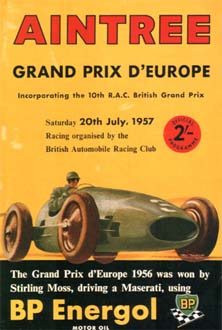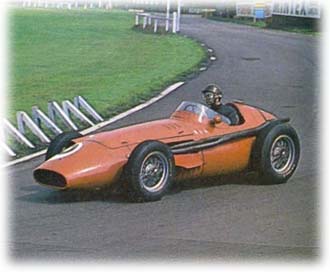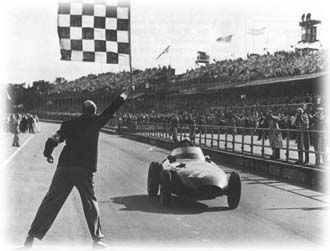|
| |||
 |
A Race to Remember | ||
| by Marcel Schot, Netherlands | |||
|
Every Grand Prix Venue has its most remembered race; that race where the mighty gods of Formula One diced and dodged to achieve eternal greatness and set the record books straight. But every Grand Prix venue also has remarkable races that were pushed aside in the history books, for no good reason. Atlas F1 writer Marcel Schot reviews, ahead of every Grand Prix this season, one race which should be memorised and valued; that one round in history which makes a Race to Remember
The British Grand Prix has always been a race full of dramatics, excitement and tradition. Together with Monza, Montecarlo and Spa-Francorchamps, Silverstone is among the most famous racing tracks in the world, having hosted many British Grands Prix since the very first World Championship race in 1950. However, Silverstone wasn't the only track to host the race. Five of those races outside Silverstone were held on Aintree. The 1957 British Grand Prix truly stands out as a turning point in Formula One history, marking the start of the return of British on top of the Formula One world.
This surprising historic win makes the race well worth remembering, especially with the way it was achieved in mind.
Before the Race
Qualifying brought the first sign of surprise of the weekend. Stirling Moss steered his Vanwall to Pole Position in a time of 2:00.2, staying 0.2 seconds ahead of Jean Behra in the Maserati and his Vanwall team-mate Tony Brooks. Especially for Brooks a front row start was quite an accomplishment, as he was still recovering from a crash at Le Mans only three weeks earlier. Fourth, 0.4 seconds behind Moss was Juan Manual Fangio. With the mighty Argentinean a runaway leader in the championship, this was a surprise of enormous proportions. The second row was a very unfamiliar place for Fangio, since he started 48 of his 51 World Championship Grands Prix from the front row. The second row was completed by Mike Hawthorn in the first Ferrari and the third Vanwall of Stuart Lewis-Evans. Behind those six drivers, Maserati's Harry Schell led home a train of three Ferrari's (Peter Collins, Maurice Trintignant and Luigi Musso).
While Brooks went into the race injured and unsure of being physically able to finish the race, he decided to drive after all, if only to have a backup car for Moss in case his car would break down.
The Race
While there were two Vanwalls on the front row, the advantage wasn't taken right away, as Jean Behra's Maserati darted into the lead after a brilliant start. However, Behra didn't last a full lap in the lead as he was quickly overtaken by Stirling Moss. Once past Behra, Moss built a steady lead, while Behra was chased by the Ferrari's of Hawthorn and Collins. Brooks, keeping up as best as he could with his injury, dropped back to fifth with Musso and Lewis-Evans behind him.
After 18 laps the number of privateer Maserati was reduced to just one, when Jo Bonnier's car developed transmission problems. This left the number of Maserati's in the race to five, still the most of any make. Meanwhile, Moss' lead steadily grew to about ten seconds. The young Lewis-Evans showed some impressive racing, passing Musso and Brooks for fifth.
Behra was now leading, with Mike Hawthorn pushing hard behind him. The two had a clear lead over Peter Collins in the second Ferrari, who was about twenty seconds behind the leaders, followed by Lewis-Evans, Brooks and Musso. By lap 35 Stirling Moss caught his first victim. He passed Fangio, who was not feeling comfortable at all with the British track. This was also the time when the first works Maserati ended its race. Argentinean Carlos Menditeguy was forced out with transmission problems. Only four laps later, the second works Maserati fell victim to mechanical problems, as Herry Schell's car suffered a broken water pump. This reduced the number of works Maserati's to two, those of Jean Behra and Juan Manuel Fangio.
By now, more and more cars developed problems. Within a few minutes both BRM engines failed, ending the races of first Les Leston and two laps later Jack Fairman. Then, after 49 laps, Fangio's struggle ended, also with a broken engine. By this time, nobody was really focused on the championship leader. Stirling Moss was putting up an incredible race. The Briton was up to fourth place by the time Fangio retired, having passed Collins and Musso. Moss now only had Lewis-Evans, Hawthorn and Behra in front of him, but the distance to the leader was still quite big.
Tony Brooks then retired Moss' former car after having dragged it around the track for 25 more laps. After 53 laps, as Peter Collins' Ferrari broke down with a water leak, Moss saw the pressure from behind fading away. However, Behra, in the only remaining works Maserati (the other Maserati in the race was Ivo Bueb's private car who was circling the track a long way behind), seemed certain of his maiden victory. Mike Hawthorn was driving very well and Moss was braking lap records time and time again, but the Frenchman was well ahead and able to defend all possible attacks.
On lap 69, the audience couldn't believe their eyes. The clutch of Jean Behra's Maserati blew apart, leaving a trail of parts behind the car. The leader was thus forced out of the race in dramatic fashion. Just after Hawthorn raced by to grab the lead, he could hardly keep his Ferrari in control. The red machine was moving all over the track and its driver was convinced his lead was short lived and his race was over. Hawthorn drove back to the pits as good as he could, removing his helmet on the way back. Once the Ferrari entered the pits, it was discovered the only damage was a puncture, caused by driving over Behra's disintegrated clutch. The wheel was replaced, Hawthorn put his helmet back on and got going again. However, his chances of a win were reduced to zero by the late stop. He rejoined the race in fifth, behind Lewis-Evans, Moss, Musso and Trintignant.
By this time Moss had the race in the bag. The Briton, well ahead for the second time in the race, brought his green Vanwall to the chequered flag some twenty seconds ahead of Musso's Ferrari, securing a spectacular win for Tony Vandervell's team. After decades of foreign domination, Britain was finally on the top step of the podium again. Mike Hawthorn finished third, with Peter Collins taking home fourth place in the third Ferrari. Fifth, five laps down, came Roy Salvadori in the first of the Coopers, followed by Bob Gerard, who was also driving a Cooper.
Conclusion
A Truly worthy Race to Remember, also if it wouldn't have been Great Britain's first World Championship race win. With three race leaders running into problems, causing them to lose their lead, dramatics were certainly at a maximum. While Behra's problem was terminal, Hawthorn and Moss saw their trouble and the struggle afterwards rewarded with a podium finish. Stirling Moss raced one of the races that earned him his spot among the all time greats of Formula One. Despite winning because of problems for others, this Moss win doesn't have the remembrance of a lucky win, because it was Moss sheer determination to strike back from a seemingly impossible position. If it weren't for Moss' determination and driving skills, Luigi Musso would have scored the second win of his career. Looking back, this might very well be the race that prevented Musso from growing to a big time driver, instead of the relatively unknown driver he has become nowadays.
|
| Marcel Schot | © 2000 Kaizar.Com, Incorporated. |
| Send comments to: schot@atlasf1.com | Terms & Conditions |
Images provided by Rainer Nyberg | |
 Stirling Moss and Tony Brooks led home the British Vanwall on British soil to bring their country its first Grand Prix win in over 30 years. This feat becomes all the more remarkable when we take the championship standings before the race into account. After four races, Juan Manuel Fangio was already 17 points ahead of the field, with his team-mate Jean Behra and Indianapolis driver Sam Hanks in second. Only Fangio and Behra had managed to score in more than one race. Tony Brooks had scored six points by finishing second in Monaco, while Moss only had one single point after four races, which he scored by setting the fastest lap in the opening round of the season in Argentina, driving his last race for Maserati.
Stirling Moss and Tony Brooks led home the British Vanwall on British soil to bring their country its first Grand Prix win in over 30 years. This feat becomes all the more remarkable when we take the championship standings before the race into account. After four races, Juan Manuel Fangio was already 17 points ahead of the field, with his team-mate Jean Behra and Indianapolis driver Sam Hanks in second. Only Fangio and Behra had managed to score in more than one race. Tony Brooks had scored six points by finishing second in Monaco, while Moss only had one single point after four races, which he scored by setting the fastest lap in the opening round of the season in Argentina, driving his last race for Maserati.

